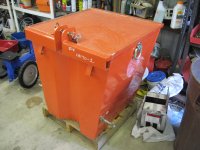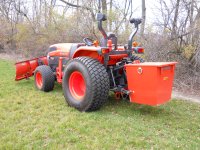I recently built a ballast box out of my leaking 60 gallon air compressor tank. Filled with scrap brake disks, drums & other steel, then some concrete & some dirt. Works good in my limited testing.
Before this I used my box blade normally or my rotary cutter if I needed maximum stability on my
L3200. Over a few months I moved a barn load of what we're allegedly 1,200lbs bales. As my lift capacity is suppose to be 1,200lbs & those bales stuck out a ways, I probably exceeded my rated lift capacity. The loader would barely lift some of those bales to 3-4' before stalling out.
I hit a mole hole once, the back end lifted & the bale fell. Major pucker factor there. I started putting 100-200lbs of random stuff on the back of my rotary cutter & it made a decent bit of difference. Still could barely lift the bales, but was noticeably more stable doing it. Still not something I enjoyed or felt that comfortable doing.
Leverage matters a lot. Adding 100lbs on the back of that 5' rotary cutter (probably 6' back from the 3pt) does more for the front axle than 300lbs on my ballast box.
Keeping the weight low really helps side hill stability. My ballast box probably isn't great here as its kind of tall.
While mowing ditches very slowly I've had my machine way over. I want to say 35-45 degrees over inching along. A couple times I've stopped moving & look over to see the high side tire still spinning. I leave it in 2wd so I have options if I get stuck & an alert that there are problems before better traction gets me in trouble.

